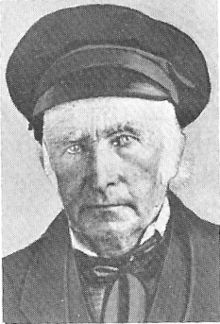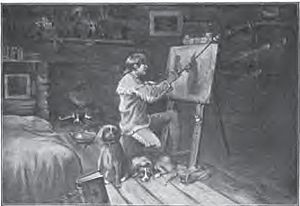- Christopher Harrison
-
For other people named Christopher Harrison, see Christopher Harrison (disambiguation).
Christopher Harrison 
1st Lieutenant Governor of Indiana In office
November 7, 1816 – December 17, 1819Preceded by None Succeeded by Ratliff Boon Personal details Born c. 1780
Cambridge, MarylandDied 1868 (aged 87–88)
Talbot County, MarylandPolitical party Democratic-Republican Party Spouse(s) None Alma mater St. John's College Religion Quaker Christopher Harrison (1780–1868) was the first Lieutenant Governor of Indiana, serving with Governor Jonathan Jennings. Harrison was briefly acting governor while Jennings' was conducting negotiation with the native tribes in northern Indiana, and later resigned from office over a dispute with Jennings. Harrison became a Quaker in his later life and freed all the slaves he inherited from his family. He lived a long life for his era, and died at age 88. There is no known relationship between Harrison and an early territorial governor of Indiana, William Henry Harrison.
Contents
Early life
Christopher Harrison was born in Cambridge, Maryland sometime around 1780, the son of the owner of a large planatation. He attended St. John's College in Annapolis, Maryland. After his graduation Harrison worked as a clerk for William Patterson, the president of the Bank of Baltimore and became a tutor for Patterson's daughter, Elizabeth. Hoosier tradition holds that Harrison courted Elizabeth and she at one point promised to marry him. However the match was opposed by her father who forced her to break off the engangment. Harrison secretly continued to carry on a love affair with Elizabeth for some time. In 1803, Elizabeth was introduced to Jérôme Bonaparte who was visiting Baltimore with the French Ambassador. Elizabeth eventually married Jérôme Bonaparte by whom she had a child. After a brief marriage Jerome abandoned Elizabeth at the request of his brother Napoleon Bonaparte, the Emperor of the French.[1] Harrison considered his reputation tarnished from this affair and he left Maryland and moved to Indiana around 1808. He settled near Hanover, Indiana where he lived for five years as a hermit in his cabin with only a dog for company.[2]
 Christopher Harrison painting in his cabin while still living as hermit near Hanover, Indiana, depicted in the book Stories of Indiana, by Maurice Thompson
Christopher Harrison painting in his cabin while still living as hermit near Hanover, Indiana, depicted in the book Stories of Indiana, by Maurice Thompson
As settlers begin to move into the territory, Harrison began to emerge from his hermitage. He was one of the founding investors of 1814 to establish the Farmers and Mechanics Bank, located in Madison, one of the first two banks in Indiana Territory. He sold his cabin in 1815 to George Logan and moved to Salem, Indiana where he opened a business in partnership with Jonathan Lyons selling dry goods. He served a one year term as Judge of Washington County on the circuit court of the Indiana Territory.[3]
Political career
In 1816, Jonathan Jennings was elected as Governor of Indiana, and he had convinced Harrison to run as his Lieutenant Governor. Harrison won the election defeating John Vawter and becoming Lieutenant Governor of Indiana. In 1817, Harrison became one of the founding members of the Grand Lodge of Indiana.[4] In 1818, Jennings left the capitol to conduct negotiations on behalf of the federal government with the native tribes in northern Indiana. While he was gone, Harrison was left as acting governor.
Harrison became involved in a scandal when Jennings returned by refusing to vacate the governorship, claiming Jennings' actions had violated the state constitution and that Jennings was no longer eligible to be governor. The constitution forbade members of the state government to hold any position in the federal government at the same time. Harrison seized the state seal and setup his own governor's office from where he attempted to run the state. After a brief period of wrangling in the state legislature, the impeachment proceedings against Jennings failed and Harrison was forced to vacate the governors position and it was returned to Jennings. Harrison became very angry with the outcome and promptly resigned his position as governor in a brief letter stating: "As the officers of the executive department of government and the General Assembly have refused to recognize and acknowledge that authority which according to my understanding is constitutionally attached to the office the name itself in my estimation is not worth retaining."[5]
The legislature accepted his resignation and passed a resolution stating: "That the House of Representatives view the conduct and deportment of Lieutenant Governor Christopher Harrison as both dignified and correct during the late investigation of the differences existing in the executive department of this State."[6]
Harrison ran against Jennings in the 1819 campaign for governor, but was soundly defeated 9,168–2,088.[6]
Jennings was conciliatory towards Harrison, and in 1821 Harrison was appointed as a member of the committee who platted Indianapolis for the new state capitol. Harrison was the only member of the commission who arrived on time to the location that was sixty miles into the wilderness. The other commissioners were long delayed in reaching the site, and Harrison, being a practical man, decided he formed a majority of the present commissioners and voted to begin laying out the town without them. He choose Alexander Ralston, who had been an assistance to Pierre Charles L’Enfant, to survey the site.[7][8][9]
In 1824 Harrison was again part of a commission that studied the possibility of building a canal around the Falls of the Ohio near Clarksville, Indiana. The commission ended after creating a report and a canal was built on the Kentucky side of the Ohio River using federal funds before Indiana could begin construction.[10]
Later life
After his short public career Harrison returned to Salem. There Harrison lived a relatively reclusive life. His home was known in the community for his many flowers, and his friendliness to the local children. Harrison was also an artist and he created many works of art including several portraits of several early Hoosiers. Some of his portraits are on display in the Indiana State Library and in the Indiana State Museum.[11]
After his father's death, Harrison sold his land in Salem on January 10, 1834 and returned to Maryland where he inherited his family's plantation which he maintained with his sister for several years. Upon taking ownership Harrison freed all of his family's slaves. Harrison joined a Quaker church during the 1840s. Harrison died at age 88 in 1868 in Talbot County, Maryland. Harrison never married.[12]
See also
Lieutenant Governor of Indiana  Harrison · Boon · Thompson · Stapp · Wallace · Hillis · Hall · Bright · Dunning · Lane · Willard · Hammond · Morton · Baker · Cumback · Sexton · Gray · Hanna · Manson · Chase · Nye · Haggard · Gilbert · Miler · Hall · O'Neill · Bush · Brunch • Van Orman • Bush • Townsend · Schricker · Dawson · James · Alexander · Watkins · Handley · Parker · Ristine · Rock • Folz · Orr · Mutz · O'Bannon · Kernan · Davis · Skillman
Harrison · Boon · Thompson · Stapp · Wallace · Hillis · Hall · Bright · Dunning · Lane · Willard · Hammond · Morton · Baker · Cumback · Sexton · Gray · Hanna · Manson · Chase · Nye · Haggard · Gilbert · Miler · Hall · O'Neill · Bush · Brunch • Van Orman • Bush • Townsend · Schricker · Dawson · James · Alexander · Watkins · Handley · Parker · Ristine · Rock • Folz · Orr · Mutz · O'Bannon · Kernan · Davis · SkillmanReferences
- ^ Maurice Thompson (1898). Stories of Indiana. American Book Company. pp. 128–130. http://books.google.com/books?id=WeEXAAAAIAAJ.
- ^ Jacob Piatt Dunn (1919). Indiana and Indianians. American Historical Society. pp. 375. http://books.google.com/books?id=_1iqwWom9wIC&pg.
- ^ Morris, Martha. Christopher Harrison, Indiana Magazine of History Volume 100, #2. (Indiana University Dept. of History, 1920) pg.103-4
- ^ Morris, Martha. Christopher Harrison, Indiana Magazine of History Volume 100, #2. (Indiana University Dept. of History, 1920) pg.107
- ^ Jacob Piatt Dunn (1919). Indiana and Indianians. American Historical Society. pp. 378. http://books.google.com/books?id=_1iqwWom9wIC&pg.
- ^ a b Jacob Piatt Dunn (1919). Indiana and Indianians. American Historical Society. pp. 379. http://books.google.com/books?id=_1iqwWom9wIC&pg.
- ^ Indiana Historical Bureau. "An Introduction to The Indianapolis Donation". IN.gov. http://www.in.gov/icpr/3062.htm. Retrieved 2008-05-31.
- ^ Maurice Thompson (1898). Stories of Indiana. American Book Company. pp. 135. http://books.google.com/books?id=WeEXAAAAIAAJ.
- ^ Jacob Piatt Dunn (1919). Indiana and Indianians. American Historical Society. pp. 363. http://books.google.com/books?id=_1iqwWom9wIC&pg.
- ^ Maurice Thompson (1898). Stories of Indiana. American Book Company. pp. 1137. http://books.google.com/books?id=WeEXAAAAIAAJ.
- ^ Mary Quick Burnet (1921). Art and Artists of Indiana. Century. pp. 448. http://books.google.com/books?id=kA9DAAAAIAAJ.
- ^ William Wesley Woollen (1975). Biographical and Historical Sketches of Early Indiana. Ayer Publishing. pp. 166. ISBN 0-405-06896-4. http://books.google.com/books?id=PCbZ8rS-84gC.
Categories:- 1868 deaths
- American Quakers
- Lieutenant Governors of Indiana
- People from Cambridge, Maryland
- 1780 births
Wikimedia Foundation. 2010.
